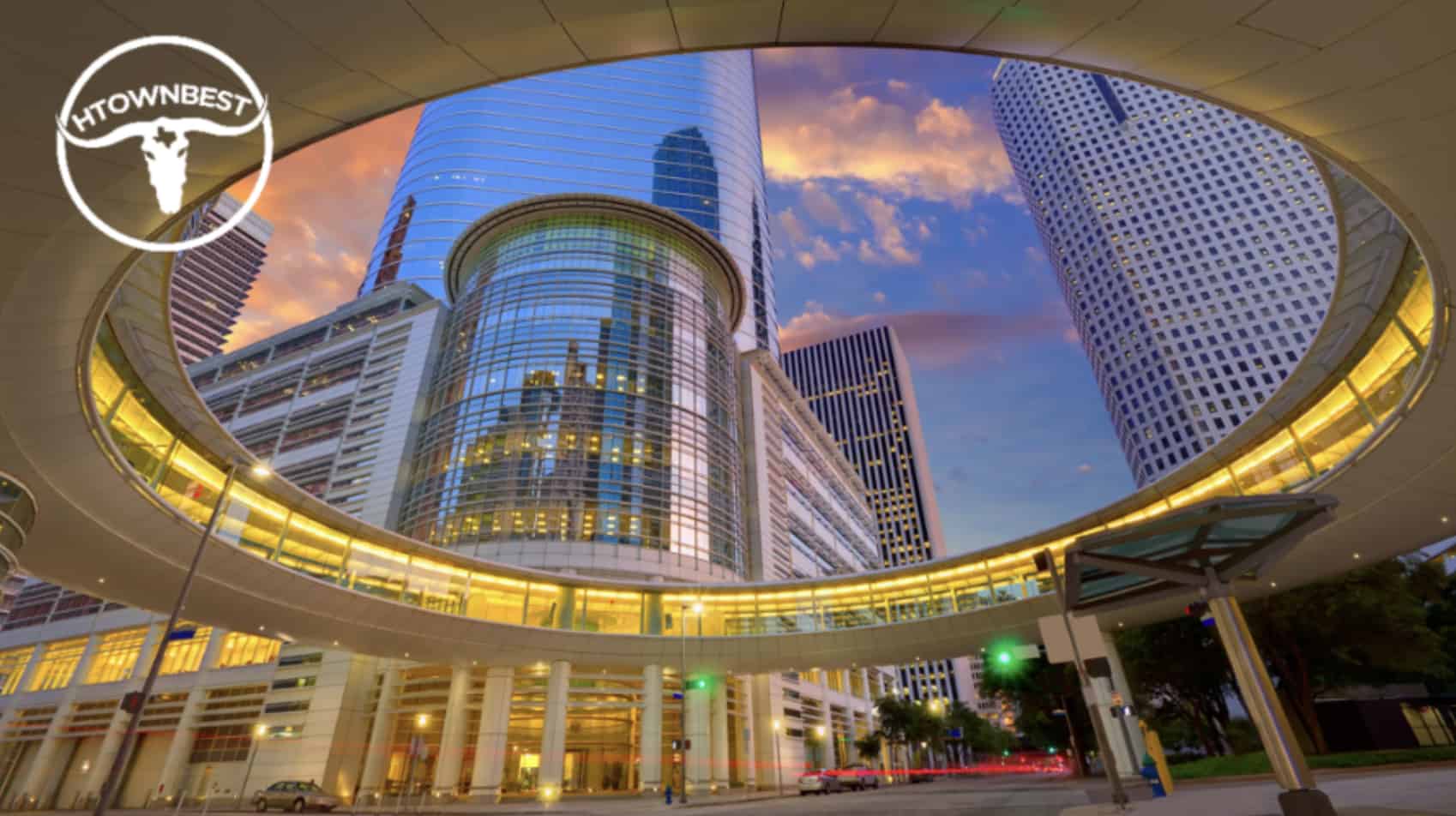Houston’s Architecture — A Guide For Architects

- What type of architecture can I expect to see in Houston?
- What neighborhoods in Houston have excellent architecture?
- Architectural Sights in River Oaks
- River Oaks Shopping Centre
- Architectural Sights in Theatre District
- Jesse H. Jones Hall
- Museum District
- Museum of Fine Arts
- Contemporary Arts Museum
- The Czech Center Museum
- Rothko Chapel
- What are the must-see architectural sites in Houston?
- Sam Houston Park
- Beer Can House
- Houston City Hall
- Williams Tower
- Bank of America Center
- Wells Fargo Bank Plaza
- Astrodome
- 1940 Air Terminal Museum
- Heritage Plaza
- JP Morgan Chase Tower
- Rice University
- TC Energy Center
- Kellum-Noble House
- Magnolia Hotel Houston
Houston doesn’t appear an exciting travel destination for those who love architectural design at first glance.
However, the city has no zoning regulations, so residential neighborhoods are full of an exciting mishmash of architectural styles.
From outside your apartment window, it may seem like steel skyscrapers make up a majority of Downtown Houston, for instance. Yet, suppose you peer a bit closer.
In that case, you’ll find burgeoning districts and a vibrant artistic scene embodied in the exteriors of Houston’s most famous sites. Yes, Houston can be exciting for architects if you know where to go.
So, what type of architecture can you expect to see in Houston?
What type of architecture can I expect to see in Houston?
Houston does not have one distinct type of architecture throughout the city, so visitors can expect to see diverse architectural styles.
Visitors can see Modern, Gothic, Greek, and Victorian architecture in its purest forms in Houston. The style of residential structures varies and is vibrant.
For example, Victorian, Colonial Revival, Neoclassical, English Manorial, and contemporary mansions cover Houston’s elite neighborhood, River Oaks.
On the other hand, urban-contemporary strip malls and structures line streets of other Houston neighborhoods with hole-in-the-wall barber shops and places with the best street tacos.
For architects looking for sleek, quirky designs, container homes are also rising throughout Houston. But you can’t get any more bizarre than a house made of beer cans (we’ll show it to you below!).
Amidst the quirky designs, ranch-style homes, bungalows, and flood-proofed housing, though, the most common architectural style in Houston is still post-war neoclassical.
What neighborhoods in Houston have excellent architecture?
River Oaks, Theatre District, and the Museum District are three Houston neighborhoods with architectural sights to behold on every street.
Architectural Sights in River Oaks

River Oaks is well-known for its upscale neighborhoods. Its variety of classic-style mansions defines the luxuries enjoyed by those in the area.
River Oaks Shopping Centre

The River Oaks Shopping Centre is next to the community center and perfect for architects looking for an example of blended styles. The location itself is significant since it was Houston’s first shopping center, opened in 1937.
It has served its purpose in the architectural development within Houston because of its unchanged Art Deco construction. The River Oaks Theater remains true to its roots of being an Arthouse theater since 1939.
Yes, you can still watch movies at this viable historic building. Still, there has been an expansion to the shopping center bringing in modern architecture with elegant glass panel buildings and luxurious lighting.
Indeed, The River Oaks Shopping Centre is a blended mixture of the old and the new.
Architectural Sights in Theatre District

Houston’s Theatre District is home to nine professional performing arts organizations. The entire district spans 17 blocks in the heart of Houston’s downtown.
The 130,000-square-foot Bayou Place entertainment complex with clubs, restaurants, and theaters is in the Theatre District. Furthermore, the iconic Alley Theatre is in the Theatre District; it is Texas’s oldest professional theater group.
The Alley Theatre’s repressed windows and thick walls help keep the Houston heat out of the building. The brutalist architectural style defines the exterior of the building, adding to the dramatic flair of the theater.
Jesse H. Jones Hall

Jesse H. Jones Hall is an eight-story structure composed of white Italian marble on the outside. Tourists visit the area for its cultural and architectural significance.
The marble concert hall ceiling comprises 800 hexagonal segments that accommodate the auditorium’s acoustics.
Museum District
The Museum District is a massive magnet for artists and art fans, with over 7 million tourists visiting each year. The Museum District has 19 museums, numerous galleries, and cultural centers.
It is also the location of the state’s first art museum, the Museum of Fine Arts. Aside from Houston’s 19 museums and art centers, The Museum District is a vibrant architectural piece.
Museum of Fine Arts

The museum’s collection extends back over 6,000 years and from six continents. The museum opened in 1900 and is notable for its neoclassical architecture.
The structures on the MFAH campus represent a diverse array of great architectural designs. Moneo’s design resulted in a three-story urban construction measuring 192,447 square feet, with over 85,000 sq. ft. set aside for gallery purposes.
Indiana limestone adorns the exterior while skylight lanterns hover over the rooftop while keeping true to its neoclassical architectural roots.
Contemporary Arts Museum

This museum showcases a variety of art. Appropriately, the structure is a work of art in and of itself.
A parallelogram with ribbed stainless steel coating. Most people stroll right by its front door because it is between two panels of steel that mirror the day’s sky.
Despite being surrounded by larger, more magnificent structures, the pointed steel edges allow this building to stand independently without apologizing to the environment.
The steel edges don’t evoke the lateral surroundings’ columns and ivy but rather mix with the sky above in a captivating performance at dark and dawn.
The Czech Center Museum

The Czech Center Museum is a Baroque castle replete with a church and ballroom. Their ballroom may not be a splitting replica of a castle ballroom, but it’s still great for dance class practice, catering events, etc.
Rothko Chapel

If you want to experience Houston’s architectural diversity, the Rothko Chapel is another must-see in the Museum District. The chapel’s interior successfully rejects tradition.
Instead, you’ll see modern art from every angle. Mark Rothko’s 14 black and colorful paintings adorn the walls of the Rothko Chapel.
What are the must-see architectural sites in Houston?
We’ve already listed the main architectural sights in Houston for 3 districts, so let’s move on to the rest below.
Sam Houston Park

The Sam Houston Park pays homage to Houston’s cultural and architectural legacy. The area is a splendid oasis of greenery and modern landmarks.
In the heart of urban life, freeways and skyscrapers surround Sam Houston Park. Within the 20-acre area, visitors may enjoy a Victorian-style village with clean footpaths leading to the historic mill.
The little river stream runs through the Park’s grounds. It’s a nice area to sit and unwind after a good evening walk. You’ll also notice the 52-year-old building inside the park, which houses a famous local school.
Part of Sam Houston Park is notable for preserving the community’s glory through Houston’s Greek architecture. St. John Church, known for its Gothic architecture in Houston, is located within the park.
Beer Can House

Beer cans, bottles, and other beer paraphernalia make up this house. It is expected to contain 50,000 beer cans and is an excellent example of recycling.
It is one of Houston’s most well-known folk art constructions and draws many tourists.
Houston City Hall

Houston City Hall is a simple structure with sophisticated detailing. It is an architectural classic created by Joseph Finger between 1938 and 1939.
While the doorways show famous historical individuals, the floors depict the government’s protective function. A stone sculpture and 27 plaster casts for friezes created by Beaumont artist Herring Coe and designer Raoul Josset are also in the building.
Williams Tower

Phillip Johnson designed the Williams Tower, formerly known as the Transco Tower. At 901 feet tall and 64 stories, it is the highest building in uptown Houston.
One of the structure’s distinguishing traits is that it is divided into two halves horizontally. The top and bottom portions have independent elevators, lobbies, and garages.
Another notable feature is the 88-foot-high granite arched entry. It also features a rotating light beacon positioned on its peaked roof.
A 3-acre park with a 64-foot sculptural fountain is adjacent to the structure. This multi-story fountain, the Williams Waterwall, contains 11,000 gallons of water tumbling down both sides per minute.
Bank of America Center

The Bank of America Centre, dubbed “Texas’ most beautiful structure,” is an exemplary example of postmodern architecture. The structure, located in downtown Houston, was designed by award-winning architect Phillip Johnson and his colleague John Burgee.
This 780-foot-tall skyscraper with 56 stories finished construction in 1983. It has characteristics of Dutch Gothic architecture that are common to Dutch canal houses.
Red Swedish granite coats the outer building, catching the eyes of many. But it may appear dark pink to some.
Wells Fargo Bank Plaza

This 71-story building, which extends four stories below street level, is the second tallest in Texas behind the JP Morgan Chase Tower.
Skidmore, Owings & Merrill, and Lloyd Jones Brewer and Associates created it in the shape of a dollar sign.
Astrodome

The Astrodome is the world’s first domed stadium, spanning over 92 acres. Roy Hofheinz designed the stadium.
The architects were Hermon Lloyd and W.B. Morgan, Wilson, Morris, Crain, and Anderson are the members. Walter P Moore Engineers and Consultants of Houston handled the structural engineering and design.
This architectural marvel is 25 feet below ground level, with a ceiling 208 feet above the playing surface.
1940 Air Terminal Museum

The Houston Municipal Airport Terminal, another of Joseph Finger’s designs, was completed in 1940. It is a traditional Art Deco tower.
It was Houston’s primary commercial airport until 1954. At the William P. Hobby Airport terminal, the 1940 Air Terminal Museum shows collections from Houston’s aviation history.
Heritage Plaza

Downtown Houston is home to the Heritage Plaza. It was created by M. Nasar and is 53 stories high.
It has a multi-level cascade that flows down from the lobby. The top of the building has a tiered granite construction resembling a Mayan Pyramid.
The crown of the skyscraper is also said to resemble a bald eagle spreading its wings.
JP Morgan Chase Tower

The JP Morgan Chase Tower, located in downtown Houston, is Texas’ tallest structure. It is also the world’s highest building with five sides rather than four.
This 75-story Art Deco tower has 1.98 million square feet of office space. I created the design. The entire edifice, designed by I.M. Pei, is made of pale grey polished granite, grey glass, and stainless steel.
The curving glass top is the most eye-catching aspect of this tower.
Rice University

Rice University is a tiny private research university most renowned for its engineering and science disciplines and Museum District campus.
This 100-year-old campus, with neo-Byzantine architecture and a realm of twisting, towering oak trees and April azaleas, reveals Houston is rather clever with intertwining architecture and nature.
TC Energy Center

The TC Energy Center, a spectacular standout among Houston’s skyline’s blue and gray colors, was completed in the 1980s. This structure, located at 700 Louisiana, has an art gallery in the foyer.
It may not be the highest building in Houston. Still, its distinctive characteristics set it apart, and Dutch canal cottages inspired its features.
Kellum-Noble House

The Kellum-Noble House at Sam Houston Park in downtown Houston, built in 1847, is the city’s oldest structure. Millions of dollars in repairs and upgrades were completed in 2014.
Hence, the residence is now the main attraction in Sam Houston Park’s historic house collection.
Magnolia Hotel Houston

Elegant 1926 hotel with a refined restaurant/lounge and a rooftop pool with city views.
The historic Magnolia House in Montgomery was erected in 1854 by entrepreneur Peter J. Willis. The house is 2,500 square feet, has five bedrooms, and stands on slightly more than an acre.





